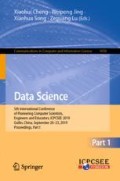Abstract
Coding cryptography can resist quantum computing attacks with high efficiency. It is similar to multivariate public key cryptography when constructing core mapping. Data compression is an advantage of coding cryptography. Therefore, combining the coding cryptography with the core mapping of multivariate public key cryptography to enhance the security of multivariate public key cryptography is a good choice. This paper first improved the Cubic Simple Matrix scheme in multivariate cryptography, and then combined the improved version scheme with the low rank parity check (LRPC) code to construct a new scheme. Compared with the Cubic Simple Matrix scheme, the ciphertext expansion rate is reduced by 50%, and the security of the scheme has been improved. The new solution is based on the improved version of the Cubic Simple Matrix, which reduces the dimensional constraints on the code when selecting LRPC codes.
Access this chapter
Tax calculation will be finalised at checkout
Purchases are for personal use only
References
Shor, P.: Polynomial-time algorithms for prime factorization and discrete logarithms on a quantum computer. SIAM J. Comput. 26(5), 1484–1509 (1994)
Bernstein, D.J., Buchmann, J., Dahmen, E. (eds.): Post Quantum Cryptography. Springer, Heidelberg (2009). https://doi.org/10.1007/978-3-540-88702-7
Bogdanov, A., Eisenbarth, T., Rupp, A., Wolf, C.: Time-area optimized public-key engines: MQ-cryptosystems as replacement for elliptic curves? In: Oswald, E., Rohatgi, P. (eds.) CHES 2008. LNCS, vol. 5154, pp. 45–61. Springer, Heidelberg (2008). https://doi.org/10.1007/978-3-540-85053-3_4
Matsumoto, T., Imai, H.: Public quadratic polynomial-tuples for efficient signature-verification and message-encryption. In: Barstow, D., et al. (eds.) EUROCRYPT 1988. LNCS, vol. 330, pp. 419–453. Springer, Heidelberg (1988). https://doi.org/10.1007/3-540-45961-8_39
Patarin, J.: Hidden fields equations (HFE) and isomorphisms of polynomials (IP): two new families of asymmetric algorithms. In: Maurer, U. (ed.) EUROCRYPT 1996. LNCS, vol. 1070, pp. 33–48. Springer, Heidelberg (1996). https://doi.org/10.1007/3-540-68339-9_4
Fell, H., Diffie, W.: Analysis of a public key approach based on polynomial substitution. In: Williams, H.C. (ed.) CRYPTO 1985. LNCS, vol. 218, pp. 340–349. Springer, Heidelberg (1986). https://doi.org/10.1007/3-540-39799-X_24
Tao, C., Diene, A., Tang, S., Ding, J.: Simple matrix scheme for encryption. In: Gaborit, P. (ed.) PQCrypto 2013. LNCS, vol. 7932, pp. 231–242. Springer, Heidelberg (2013). https://doi.org/10.1007/978-3-642-38616-9_16
Ding, J., Petzoldt, A., Wang, L.-C.: The cubic simple matrix encryption scheme. In: Mosca, M. (ed.) PQCrypto 2014. LNCS, vol. 8772, pp. 76–87. Springer, Cham (2014). https://doi.org/10.1007/978-3-319-11659-4_5
Mceliece, R.J.: A public-key cryptosystem based on algebraic. Coding Thv 4244, 114–116 (1978)
Niederreiter, H.: Knapsack-type cryptosystems and algebraic coding theory. Probl. Control Inf. Theor. 15(2), 159–166 (1986)
Li, Z., Yang, Y., Li, Z.: Design of public key cryptosystem based on QC-MDPC code. Comput. Appl. Res. 32(03), 881–884 (2015)
Becker, O.: Symmetric unique neighbor expanders and good LDPC codes. Discrete Appl. Math. 211, 211–216 (2016)
Gaborit, P., Ruatta, O., Schrek, J., Zémor, G.: New results for rank-based cryptography. In: Pointcheval, D., Vergnaud, D. (eds.) AFRICACRYPT 2014. LNCS, vol. 8469, pp. 1–12. Springer, Cham (2014). https://doi.org/10.1007/978-3-319-06734-6_1
Han, Y., Lan, J., Yang, X.: Signcryption scheme based on LRPC code and multivariable. J. Crypt. 3(01), 56–66 (2016)
Wang, H.Z., Shenc, X., Xuz, Q., et al.: Multivariate public-key encryption scheme based on error correcting codes. China Commun. 8(4), 23–31 (2011)
Han, Y., Lan, J., Yang, X., Wang, J.: Multivariable encryption scheme combined with low rank error correction coding. J. Huazhong Univ. Sci. Technol. (Nat. Sci. Ed.), 44(03), 71–76 (2016)
Faugere, J.C.: A new efficient algorithm for computing Gröbner bases without reduction to zero (F5). In: Proceedings of the 2002 International Symposium on Symbolic and Algebraic Computation, pp. 75–83. ACM (2002)
Faugere, J.C.: A new efficient algorithm for computing Gröbner bases (F4). J. Pure Appl. Algebra 139, 61–88 (1999)
Ding, J., Buchmann, J., Mohamed, M.S.E., Mohamed, W.S.A.E., Weinmann, R.-P.: Mutant XL. In: Talk at the First International Conference on Symbolic Computation and Cryptography (SCC 2008), Beijing (2008)
Goubin, L., Courtois, N.T.: Cryptanalysis of the TTM cryptosystem. In: Okamoto, T. (ed.) ASIACRYPT 2000. LNCS, vol. 1976, pp. 44–57. Springer, Heidelberg (2000). https://doi.org/10.1007/3-540-44448-3_4
Coppersmith, D., Stern, J., Vaudenay, S.: Attacks on the birational permutation signature schemes. In: Stinson, Douglas R. (ed.) CRYPTO 1993. LNCS, vol. 773, pp. 435–443. Springer, Heidelberg (1994). https://doi.org/10.1007/3-540-48329-2_37
Ding, J., Schmidt, D.: Rainbow, a new multivariable polynomial signature scheme. In: Ioannidis, J., Keromytis, A., Yung, M. (eds.) Applied Cryptography and Network Security ACNS 2005. LNCS, vol. 3531, pp. 164–175. Springer, Heidelberg (2005). https://doi.org/10.1007/11496137_12
Acknowledgment
This work was supported by the National Natural Science Foundation of China (No. 61572521).
Author information
Authors and Affiliations
Corresponding author
Editor information
Editors and Affiliations
Rights and permissions
Copyright information
© 2019 Springer Nature Singapore Pte Ltd.
About this paper
Cite this paper
Wang, Z., Han, Y. (2019). Anti-quantum Cryptography Scheme Based on the Improvement of Cubic Simple Matrix and LRPC Code. In: Cheng, X., Jing, W., Song, X., Lu, Z. (eds) Data Science. ICPCSEE 2019. Communications in Computer and Information Science, vol 1058. Springer, Singapore. https://doi.org/10.1007/978-981-15-0118-0_29
Download citation
DOI: https://doi.org/10.1007/978-981-15-0118-0_29
Published:
Publisher Name: Springer, Singapore
Print ISBN: 978-981-15-0117-3
Online ISBN: 978-981-15-0118-0
eBook Packages: Computer ScienceComputer Science (R0)

